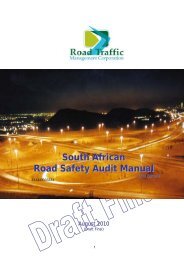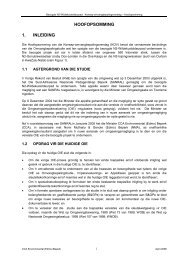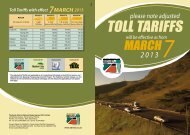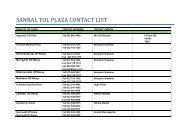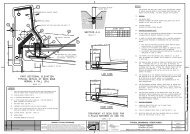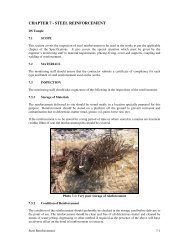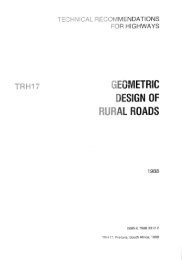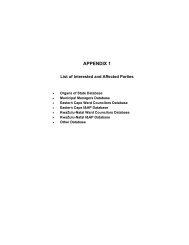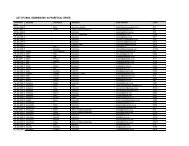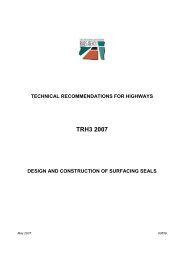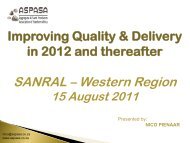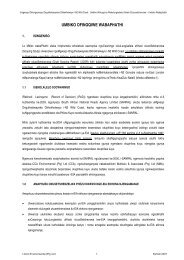SAPEM Chapter 2 - Sanral
SAPEM Chapter 2 - Sanral
SAPEM Chapter 2 - Sanral
Create successful ePaper yourself
Turn your PDF publications into a flip-book with our unique Google optimized e-Paper software.
South African Pavement Engineering Manual<br />
<strong>Chapter</strong> 2: Pavement Composition and Behaviour<br />
Figure 6. AASHO Road Test (AASHTO, 1961)<br />
The cost of the AASHO road test was $29 million in 1954 (equivalent to about $300 million in 1996). As a result of<br />
the experiment, for the first time the relationship between performance and loading was investigated. The main<br />
findings were:<br />
Definition of serviceability as the degree to which the road pavement serves the road users.<br />
Development of the Present Serviceability Rating (PSR), where road users rated the serviceability of various<br />
roads.<br />
Present Serviceability Index (PSI) was developed when it was shown<br />
that the PSR was more closely correlated with riding quality than with any<br />
other variable. Hence, it became possible to estimate the PSR from more<br />
objective measurements of roughness, rather than from subjective user<br />
ratings.<br />
The concept of load equivalency was defined where the equivalent<br />
damage caused by different axle loads and configurations was quantified<br />
relative to the 80 kN single axle that was the norm at the time. The<br />
AASHO road test showed that different equivalencies also existed for<br />
different pavement types (asphalt and concrete).<br />
The load equivalency factor is normally simplified using Equation (1):<br />
E80s & MESA<br />
An E80 is an equivalent 80 kN<br />
axle load. Typically, varying<br />
axle loads are converted to<br />
E80s using Equation 1.<br />
Another popular term is MESA,<br />
which is Million Equivalent<br />
Standard Axles.<br />
( ) (1)<br />
where<br />
LEF<br />
P<br />
80<br />
n<br />
=<br />
=<br />
=<br />
=<br />
Load equivalency factor, the relative damage caused by<br />
axle load P compared to a 80 kN single axle load<br />
Axle load (kN)<br />
Equivalent Standard Axle Load (ESAL or E80) in (kN)<br />
damage exponent<br />
The damage exponent depends on the pavement and distress type, but typically 4.2 is used for flexible pavements in<br />
South Africa. See <strong>Chapter</strong> 10, Section 4.1.3.<br />
A design method was developed from the results of the AASHO Road Test, known as the AASHTO Structural Number<br />
method (AASHTO, 1986). This method is discussed in <strong>Chapter</strong> 10, Section 7.4.<br />
2.3 Necessity of Roads<br />
In the modern world it is well known that apart from social factors such as transport to hospitals, quick access to a<br />
fire and emergencies, visiting friends and tourism, a good road system is the backbone for all kinds of economic<br />
activity.<br />
It is generally acknowledged that global competitiveness requires good road infrastructure. Rural road construction is<br />
enormously important and plays a major role in stimulating the economy (farm to market routes). This has been<br />
Section 2: History<br />
Page 6



